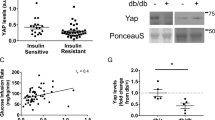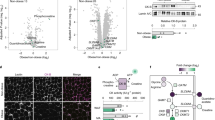Abstract
Insulin resistance is a pivotal feature in the pathogenesis of type 2 diabetes, and it may be detected 10–20 y before the clinical onset of hyperglycemia. Insulin resistance is due to the reduced ability of peripheral target tissues to respond properly to insulin stimulation. In particular, impaired insulin-stimulated muscle glycogen synthesis plays a significant role in insulin resistance. Glucose transport (GLUT4), phosphorylation (hexokinase) and storage (glycogen synthase) are the three potential rate-controlling steps regulating insulin-stimulated muscle glucose metabolism, and all three have been implicated as being the major defects responsible for causing insulin resistance in patients with type 2 diabetes. Using 13C/31P magnetic resonance spectroscopy (MRS), we demonstrate that a defect in insulin-stimulated muscle glucose transport activity is the rate-controlling defect. Using a similar 13C/31P MRS approach, we have also demonstrated that fatty acids cause insulin resistance in humans due to a decrease in insulin-stimulated muscle glucose transport activity, which could be attributed to reduced insulin-stimulated IRS-1-associated phosphatidylinositol 3-kinase activity, a required step in insulin-stimulated glucose transport into muscle. Furthermore, we have recently proposed that this defect in insulin-stimulated muscle glucose transport activity may be due to the activation of a serine kinase cascade involving protein kinase Cθ and IKK-β, which are key downstream mediators of tissue inflammation. Finally, we propose that any perturbation that leads to an increase in intramyocellular lipid (fatty acid metabolites) content such as acquired or inherited defects in mitochondrial fatty acid oxidation, defects in adipocyte fat metabolism or simply increased fat delivery to muscle/liver due to increased energy intake will lead to insulin resistance through this final common pathway. Understanding these key cellular mechanisms of insulin resistance should help elucidate new targets for treating type 2 diabetes.
This is a preview of subscription content, access via your institution
Access options
Subscribe to this journal
Receive 12 print issues and online access
$259.00 per year
only $21.58 per issue
Buy this article
- Purchase on Springer Link
- Instant access to full article PDF
Prices may be subject to local taxes which are calculated during checkout
Similar content being viewed by others
Author information
Authors and Affiliations
Corresponding author
Rights and permissions
About this article
Cite this article
Perseghin, G., Petersen, K. & Shulman, G. Cellular mechanism of insulin resistance: potential links with inflammation. Int J Obes 27 (Suppl 3), S6–S11 (2003). https://doi.org/10.1038/sj.ijo.0802491
Published:
Issue Date:
DOI: https://doi.org/10.1038/sj.ijo.0802491
Keywords
This article is cited by
-
Integrating in silico molecular docking, ADMET analysis of C.verticillata with diabetic markers and in vitro anti-inflammatory activity
Future Journal of Pharmaceutical Sciences (2024)
-
The impact of reactive oxygen species in the development of cardiometabolic disorders: a review
Lipids in Health and Disease (2021)
-
NAFLD/NASH in patients with type 2 diabetes and related treatment options
Journal of Endocrinological Investigation (2018)
-
Adipogenesis and lipid production in adipocytes subjected to sustained tensile deformations and elevated glucose concentration: a living cell-scale model system of diabesity
Biomechanics and Modeling in Mechanobiology (2018)



